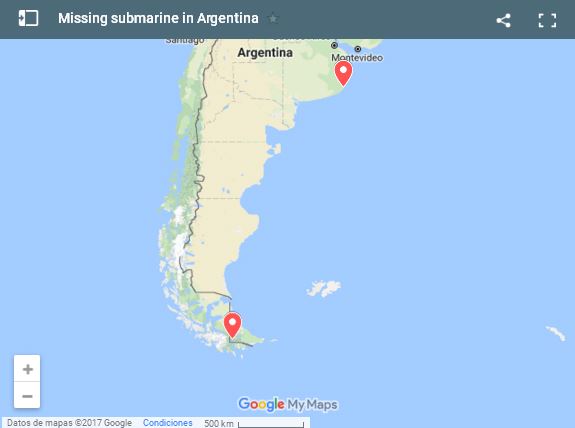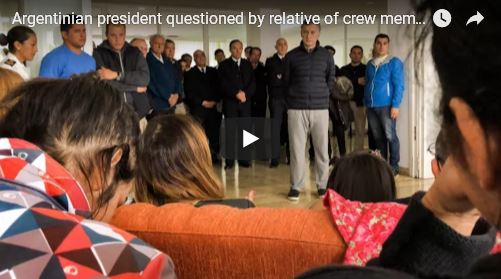It’s been over a week since a navy submarine disappeared off the coast of Argentina, and time is running out for the 44 people on board.
A spokesman for the Argentine navy said that the search for the ARA San Juan had now entered a “critical phase,” as the crew’s oxygen supply may be close to running out.
Over a dozen countries, including the United States, have contributed to the search effort. On Wednesday, the Argentine navy said it was investigating after reports emerged of a loud noise detected in the hours after the sub went missing.

File picture released by Telam showing the ARA San Juan submarine being delivered to the Argentine Navy after being repaired at the Argentine Naval Industrial Complex (CINAR) in Buenos Aires, Argentina, on May 23, 2014. The sub went missing on November 15. ALEJANDRO MORITZ/AFP/GETTY
Where happened to the ARA San Juan?
The sub was on a routine mission last week, traveling back from Ushuaia—a city close to the southernmost tip of South America—to the Mar del Plata naval base.
The sub’s crew made contact with the navy, reporting an “electrical breakdown,” according to naval commander Gabriel Galeazzi. The sub surfaced to report the problem, which Galeazzi described as a “short circuit” in the vessel’s batteries.
The sub was ordered to return immediately to Mar del Plata. But according to a BBC report, the captain made contact with the naval base once more, around 7:30 a.m. local time on November 15, to say that a temporary fix had been made for the problem; the sub would submerge and travel directly to the base.

Since then, there has been no contact from the submarine. On Thursday the Guardian reported that Argentine navy spokesman, Captain Enrique Balbi, said search teams had returned to an area some 30 miles north of the sub’s last registered position, after a “hydro-acoustic anomaly” was detected by the U.S. and others.
The noise occurred a few hours after final contact on November 15. Balbi said they didn’t want to speculate on what caused it and refused to confirm whether it could have been caused by an explosion.
Who is onboard the sub?
The 66-meter sub—which was built in Germany in 1983—is carrying a crew of 44 submariners. Forty-three of the crew members are male, but the sub is also carrying Eliana Maria Krawczyk, the first female submarine officer in Argentina.
Krawczyk, 35, was born in the landlocked Argentine province of Misiones and joined the navy in 2004. She graduated from the country’s submarine and diving school in 2012, and her sister told Reuters that she had been aboard the ARA San Juan when it made the same trip from Ushuaia in 2016 without incident. “It is like she was born for this,” said Silvina Krawczyk. “She really likes to do what she does in the navy.”
 Maria Krawczyk, a submarine officer on board the Argentine navy submarine ARA San Juan—which went missing in the South Atlantic on November 15—is seen in this still image taken from a Ministry of Defense of Argentina video obtained by Reuters.MINISTERIO DE DEFENSA DE ARGENTINA/VIA REUTERS
Maria Krawczyk, a submarine officer on board the Argentine navy submarine ARA San Juan—which went missing in the South Atlantic on November 15—is seen in this still image taken from a Ministry of Defense of Argentina video obtained by Reuters.MINISTERIO DE DEFENSA DE ARGENTINA/VIA REUTERS
The sub was under the command of Pedro Martin Fernandez at the time of the incident.
Who is looking for the submarine?
Argentina’s President Mauricio Macri has promised to devote all the resources required to find the ARA San Juan. Macri met with the families of the missing sailors at Mar del Plata on Monday.
The United States has sent four unmanned underwater vehicles (UUVs) and two search planes to try and find the lost sub. A NASA research plane has flown over the search area but failed to find anything. The UUVs will use sonar imaging technology to create images of the sea floor, which could help to find the sub if it is on the seabed.
President Donald Trump said he had ordered the mission. “45 people aboard and not much time left. May God be with them and the people of Argentina!” said Trump, citing an incorrect figure for the number of crew.
Other countries including Russia, the U.K. and Brazil are among those that have deployed resources, ships or planes to help with the search.
How long do the sailors have?
Officials have said that the submarine has an oxygen supply of around seven or eight days maximum. But if the sub has managed to surface during the period it has been missing, it may have been able to replenish its oxygen supply.
Submariners are trained to slow down their breathing rates and reduce activity to reduce oxygen when a problem occurs. But if there was a problem with the sub’s power supply, this too could endanger the crew: generators are often used on subs to separate oxygen from water through a process known as electrolysis.
 People pray outside Argentina's Navy base in Mar del Plata, on the Atlantic coast south of Buenos Aires, while the search for the missing ARA San Juan submarine continues, on November 22.EITAN ABRAMOVICH/AFP/GETTY
People pray outside Argentina's Navy base in Mar del Plata, on the Atlantic coast south of Buenos Aires, while the search for the missing ARA San Juan submarine continues, on November 22.EITAN ABRAMOVICH/AFP/GETTY
What are the families saying?
Many of the family members of the missing crew have criticized the navy and Argentina’s government for a slow response. A video of President Macri meeting with family members has been widely shared; in the video, a woman berates the president for deploying a 34-year-old sub on the 10-day journey, saying it was “practically suicide to send them out in something so old.”

(https://www.youtube.com/watch?v=YF6k23XD_rQ)
Family members said on Sunday that they had received messages from crew members before contact was lost; they spoke of a problem with the sub’s batteries. Captain Galeazzi only confirmed on Monday that the sub had reported an issue on November 15, but said that no distress signal had been sent out.
There’s been criticism of delays in releasing information and a lack of communication between the Argentine navy and government. According to Argentine news site Infobae, the country’s defense minister, Oscar Aguad, only learned that the sub was missing after reading it in the press.
(newsweek)